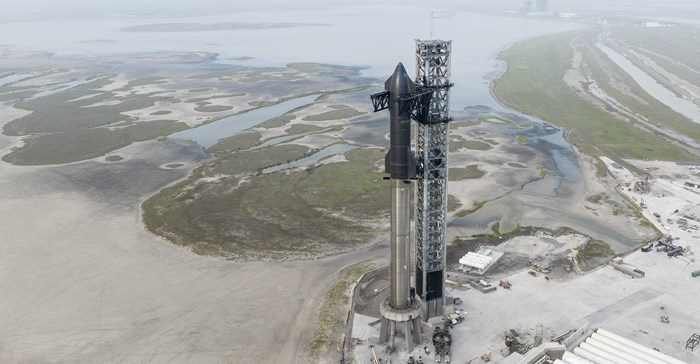SpaceX’s Starship stands apart as a remarkable feat of engineering. At a towering 121 meters, it is the largest and most powerful rocket ever constructed. Designed for full reusability, it can carry an impressive 150 tonnes of payload into low Earth orbit, ushering in unprecedented potential for space exploration. It’s latest successful test launch gets humanity one step closer to true space travel.

Starship mounted on the Super Heavy first stage booster ahead of its recent test launch. Source: SpaceX/Flickr
Starship operates on a unique blend of methane and liquid oxygen (often termed “methalox”). This fuel choice plays a pivotal role in SpaceX’s reusability goals and its long-term vision of reaching Mars.
Methane combustion produces less soot than traditional rocket fuels, minimising buildup within the Raptor engines – a critical factor for their repeated use.
More significantly, methane can be synthesised directly on the Martian surface using the planet’s carbon dioxide atmosphere. This capability offers the potential for Starship to refuel on Mars, enabling future return journeys.
That e-methane method, first discovered in 1897 by Monsieur Sabatier and a colleague who combined hydrogen (H2) with carbon dioxide (CO2) in the presence of a catalyst to create methane (CH4) and water (H2O), is currently being refined by researchers as a viable option for transporting and using green hydrogen.
However, obtaining the reactants, hydrogen and capturing CO2 are the bottlenecks. Hydrogen production demands costly methods, and capturing CO2, whether from emission sources or the atmosphere, adds to the expense.
Consequently, e-methane’s touted carbon neutrality hinges on green hydrogen sourced from renewable energy and captured CO2.
Combustion breakthroughs and versatility
The Raptor engines powering Starship represent a significant advancement in rocket technology. They are the first full-flow, staged combustion engines to achieve flight.
In contrast to traditional engines, which partially waste fuel, Raptors maximise efficiency by utilising their entire propellant supply. This power and efficiency are fundamental to Starship’s reusability aspirations and ambitious Mars missions.
These engine advances and modular design allows Starship to be a potential multifaceted tool for space exploration and transport.
Lunar missions: Starship is undergoing modifications for Moon landings, potentially supporting the establishment of a lunar base.
Deep space refuelling: SpaceX contemplates the creation of orbital fuel depots – Starships filled with propellant – to replenish spacecraft on deep space expeditions.
New telescopes: Starship’s vast payload capacity could facilitate the launch of telescopes significantly larger than even the James Webb Space Telescope.
A long journey ahead
There are substantial hurdles to overcome before Starship can unlock its potential. The Super Heavy booster must consistently execute its complex “catch” landing manoeuvre which SpaceX has yet to successfully demonstrate.
The last launch also showed that Starship’s heat shield system and re-entry technique require refinement to ensure safe return from orbit.
There are also legitimate concerns regarding the environmental footprint of frequent Starship launches, despite its cleaner fuel and the balance between SpaceX’s prioritisation of Starlink satellite launches and its aspirational exploration goals remains a topic of debate.
While the exact details of the deal between SpaceX and T-Mobile for Low Earth Orbit (LEO) data satellites haven’t been publicly disclosed, it’s an intriguing development that could bring better connectivity to underserved areas.
Current Starlink satellites are designed for broadband internet, not directly connecting mobile phones. Modifying Starlink satellites or integrating them with T-Mobile’s network would require technical adaptations and a larger vehicle to deploy into space.
A new space age
Starship will be a transformative force in spaceflight, even if it remains as just a replacement for the space shuttle. If SpaceX achieves reusability and executes those daring Mars landings, it will catalyse a new era in our ability to access and explore space.
The full implications – lunar outposts, voyages to distant planets, or a further proliferation of Earth orbit satellites alongside a renewed ability to send crewed missions to work in orbit – will usher in a new space age.










